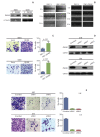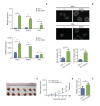ZNF488 Enhances the Invasion and Tumorigenesis in Nasopharyngeal Carcinoma Via the Wnt Signaling Pathway Involving Epithelial Mesenchymal Transition
- PMID: 25779368
- PMCID: PMC4720103
- DOI: 10.4143/crt.2014.311
ZNF488 Enhances the Invasion and Tumorigenesis in Nasopharyngeal Carcinoma Via the Wnt Signaling Pathway Involving Epithelial Mesenchymal Transition
Abstract
Purpose: The purpose of this study was to investigate the function of Zinc finger protein 488 (ZNF488) in nasopharyngeal carcinoma (NPC).
Materials and methods: The endogenous expression of ZNF488 in NPC tissues, normal nasopharyngeal epithelium tissues and NPC cell lines were detected by quantitative reverse transcription polymerase chain reaction. ZNF488 over-expressing and knock-down NPC cell line models were established through retroviral vector pMSCV mediated over-expression and small interfering RNA (siRNA) mediated knock-down. The invasion and migration capacities were evaluated by wound healing and transwell invasion assays in ZNF488 over-expressing and control cell lines. Soft-agar colony formation and a xenograft experiment were performed to study tumorigenic ability in vitro and in vivo. Immunofluorescence and western blotting analysis were used to examine protein changes followed by ZNF488 over-expression. Microarray analysis was performed to explore gene expression profilings, while luciferase reporter assay to evaluate the transcriptive activity of Tcf/Lef.
Results: ZNF488 was over-expressed in NPC tissues compared with normal tissues, especially higher in 5-8F and S18, which are well-established high metastatic NPC clones. Functional studies indicate that over-expression of ZNF488 provokes invasion, whereas knock-down of ZNF488 alleviates invasive capability. Moreover, over-expression of ZNF488 promotes NPC tumor growth both in vitro and in vivo. Our data further show that over-expression of ZNF488 induces epithelial mesenchymal transition (EMT) by activating the WNT/β-catenin signaling pathway.
Conclusion: Our data strongly suggest that ZNF488 acts as an oncogene, promoting invasion and tumorigenesis by activating the Wnt/β-catenin pathway to induce EMT in NPC.
Keywords: Carcinogenesis; Epithelial-mesenchymal transition; Invasion; Nasopharyngeal carcinoma; Wnt signaling pathway; ZNF488.
Conflict of interest statement
Conflict of interest relevant to this article was not reported.
Figures




Similar articles
-
YPEL3 suppresses epithelial-mesenchymal transition and metastasis of nasopharyngeal carcinoma cells through the Wnt/β-catenin signaling pathway.J Exp Clin Cancer Res. 2016 Jul 11;35(1):109. doi: 10.1186/s13046-016-0384-1. J Exp Clin Cancer Res. 2016. PMID: 27400785 Free PMC article.
-
Exosomal miR-18a-5p promotes EMT and metastasis of NPC cells via targeting BTG3 and activating the Wnt/β-catenin signaling pathway.Cell Cycle. 2023 Jul;22(13):1544-1562. doi: 10.1080/15384101.2023.2216508. Epub 2023 Jun 7. Cell Cycle. 2023. PMID: 37287276 Free PMC article.
-
OVOL2 links stemness and metastasis via fine-tuning epithelial-mesenchymal transition in nasopharyngeal carcinoma.Theranostics. 2018 Mar 8;8(8):2202-2216. doi: 10.7150/thno.24003. eCollection 2018. Theranostics. 2018. PMID: 29721073 Free PMC article.
-
Cell-cell adhesion: linking Wnt/β-catenin signaling with partial EMT and stemness traits in tumorigenesis.F1000Res. 2018 Sep 18;7:F1000 Faculty Rev-1488. doi: 10.12688/f1000research.15782.1. eCollection 2018. F1000Res. 2018. PMID: 30271576 Free PMC article. Review.
-
Wnt/β-catenin signalling in prostate cancer.Nat Rev Urol. 2012 Aug;9(8):418-28. doi: 10.1038/nrurol.2012.116. Epub 2012 Jun 19. Nat Rev Urol. 2012. PMID: 22710668 Review.
Cited by
-
Cancer astrocytes have a more conserved molecular status in long recurrence free survival (RFS) IDH1 wild-type glioblastoma patients: new emerging cancer players.Oncotarget. 2018 May 8;9(35):24014-24027. doi: 10.18632/oncotarget.25265. eCollection 2018 May 8. Oncotarget. 2018. PMID: 29844869 Free PMC article.
-
Differences in Zbtb7a expression cause heterogeneous changes in human nasopharyngeal carcinoma CNE3 sublines.Oncol Lett. 2017 Sep;14(3):2669-2676. doi: 10.3892/ol.2017.6553. Epub 2017 Jul 8. Oncol Lett. 2017. PMID: 28927029 Free PMC article.
-
Integrating E-cadherin expression levels with TNM staging for enhanced prognostic prediction in colorectal cancer patients.BMC Cancer. 2025 Jan 27;25(1):150. doi: 10.1186/s12885-025-13539-9. BMC Cancer. 2025. PMID: 39871234 Free PMC article.
-
Mifepristone increases mRNA translation rate, triggers the unfolded protein response, increases autophagic flux, and kills ovarian cancer cells in combination with proteasome or lysosome inhibitors.Mol Oncol. 2016 Aug;10(7):1099-117. doi: 10.1016/j.molonc.2016.05.001. Epub 2016 May 17. Mol Oncol. 2016. PMID: 27233943 Free PMC article.
-
Overexpression of Teashirt Homolog 2 suppresses cell proliferation and predicts the favorable survival of Lung Adenocarcinoma.Int J Med Sci. 2021 Mar 3;18(9):1980-1989. doi: 10.7150/ijms.52109. eCollection 2021. Int J Med Sci. 2021. PMID: 33850468 Free PMC article.
References
Publication types
MeSH terms
Substances
LinkOut - more resources
Full Text Sources
Other Literature Sources

